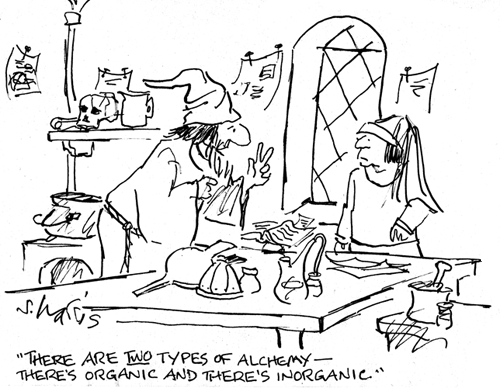From Alchemy to Chemistry

Alchemy was chemistry in its infancy.
Everybody knows what fire is, it’s what happens when you burn something. Often used for cooking and warmth, fire comes from a chemical reaction called combustion. The combustion reaction is one of the first known chemical reactions that was controlled and utilized by humans. A combustion reaction is simple: you burn something with carbon and hydrogen (and maybe oxygen), and an immense amount of heat is released as the burning compound reacts with oxygen in the air to create carbon dioxide and water vapor (yes, fire makes water).
Some of the first metals humans obtained in their pure form were copper, silver, and gold. Early on, humans learned that metals could be isolated and useful compounds could be created by heating metal ores and mixtures of compounds, respectively. This process gave rise to an early form of chemistry and metallurgy. As humans became acquainted with primitive chemical processes, a new field, often now called an early form of chemistry, was born: alchemy.

The birth of organic and inorganic chemistry.
Alchemy was a field devoted to determining a way to make ordinary materials into gold, a highly valuable commodity. Nowadays, we know that this is not possible through chemical processes. Elements are substances that cannot be changed through chemical processes, and alchemists DEFINITELY did not know about nuclear processes that could make gold.
As alchemists tried and tried and tried to create some magical substance that could turn everything into gold, alchemists accidentally discovered early chemical concepts, analytical techniques, and even new elements.
Alchemist Jãbir ibn Hayyãn discovered that some substances could be broken down, while others could not. Other Arab alchemists discovered that each substance gave a colored flame when burned, what we now call the flame test. Alchemist Hennig Brand discovered the element phosphorus by boiling down his urine; he thought the golden color of urine held the secret to the magical substance that could turn anything into gold. Alchemists provided the necessary foundations for alchemy to transcend into chemistry. All they needed was some fresh air.

Alchemy had its flaws.
An important theory in alchemy called the Phlogiston theory claimed the existence of a substance called phlogiston. Burning metal ores with a phlogiston-rich substance such as coal produced a metal that was infused with phlogiston from the coal. As metals rust, they lose their infused phlogiston, causing the metal to weaken and fall apart. The problem with this theory was that when metals rusted and LOST their infused phlogiston, the metals GAINED mass. The discovery of numerous gasses during the late 18th century would not only disprove the phlogiston theory, but it would also disprove the fundamentality of a common substance: air. In 1766, chemist Henry Cavendish reacted metal zinc and iron with strong acids and created what he called “inflammable gas” (hydrogen gas). Soon after, chemists Joseph Black and Joseph Priestley discovered phlogisticated air (carbon dioxide) and dephlogisticated air (oxygen gas), respectively.
What made these discoveries so important was that a chemist named Antoine Lavoisier discovered that air was absorbed by metals to create rust, refuting the phlogiston theory. The discovery of oxygen gas made Antoine Lavoisier discover that air was not a fundamental substance, and a part of the air – oxygen gas – was the gas responsible for rusting metals. The discovery of oxygen gas also helped Antoine Lavoisier establish the law of conservation of mass. The law of conservation of mass states that mass is neither created nor lost in any process.
“If everything in chemistry is explained in a satisfactory manner without the help of phlogiston, it is by that reason alone infinitely probable that the principle does not exist; that it is a hypothetical body, a gratuitous supposition; indeed, it is in the principles of good logic, not to multiply bodies without necessity.” - Antoine Lavoisier
With the theory of phlogiston gone, chemistry was born.
Since the work of Antoine Lavoisier, chemistry has grown remarkably. Batteries have been created, electricity has been used to isolate reactive elements, the theory of atoms has been established, subatomic particles have been discovered, even Albert Einstein contributed to chemistry by showing how the movement of atoms cause very light particles to move seemingly randomly.
For a series I LOVE on the history of chemistry, you can watch the series The Mystery of Matter: Search for the Elements, links below